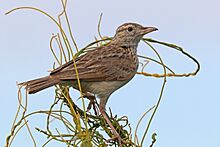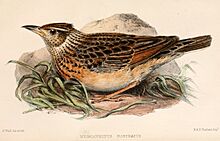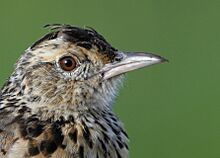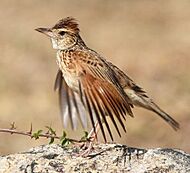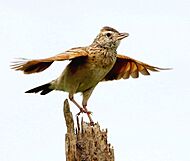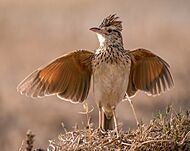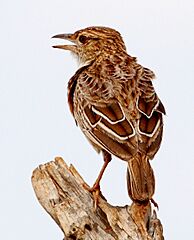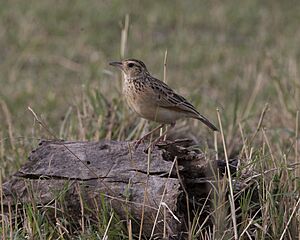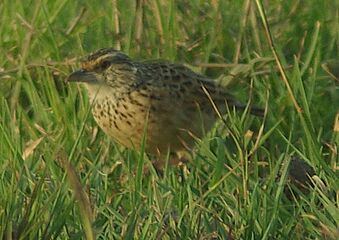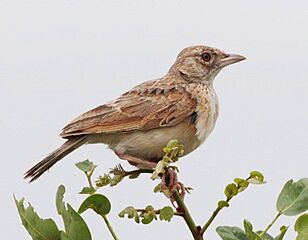Rufous-naped lark facts for kids
Quick facts for kids Rufous-naped lark |
|
|---|---|
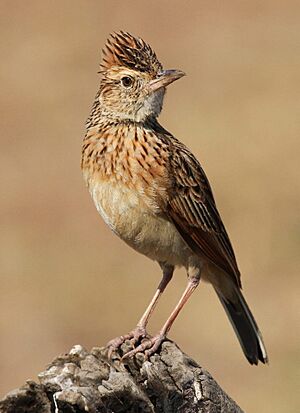 |
|
| Adult male M. a. transvaalensis | |
| Conservation status | |
| Scientific classification | |
| Genus: |
Mirafra
|
| Species: |
africana
|
| Subspecies | |
|
23, see text |
|
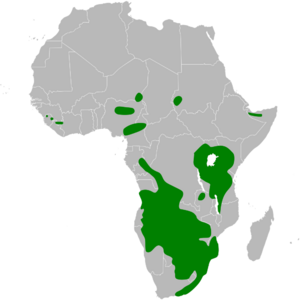 |
|
| resident range | |
The rufous-naped lark (Mirafra africana) is a common bird found in many parts of Africa. It belongs to the lark family. You can spot it in open grasslands, savannas, and farmlands.
Male rufous-naped larks are known for their special way of attracting mates. They fly up and flutter their wings from a high spot. This display is often joined by a beautiful, loud whistle. This simple display might be an early version of the wing-clapping displays seen in other types of larks. These birds have reddish-brown outer wings and a small crest that can stand up. Their feathers can look different depending on where they live.
Contents
Understanding Rufous-Naped Larks
The rufous-naped lark is a very diverse bird. It has many different forms across its wide home range. Scientists think it forms a "species complex." This means it's a group of closely related birds that might be turning into new species. For example, it's related to the red-winged lark and possibly the Somali lark.
The rufous-naped lark is smaller than the red-winged lark. It also has a thinner beak and a shorter tail. Even where their homes meet, they do not mix their features. The reddish nape (back of the neck) is not always present. Some birds, especially those in tropical areas, do not have it.
Scientists have identified many different types, or subspecies, of the rufous-naped lark. There are about 23 to 25 known subspecies. Some of these types are very similar. Others, like the blackish lark, look quite different. The blackish lark lives in high mountains. Malbrant's lark, found in central Africa, has a unique display flight.
Sharpe's lark, from Somalia, has plain, reddish upper parts. Some experts think it is a separate species. Its small home is shrinking due to too much grazing. The Somali lark is also sometimes considered a type of rufous-naped lark. But it has a very long beak and white tail feathers.
Different Types of Rufous-Naped Larks
Here are some of the recognized subspecies:
- M. a. henrici: Found from Guinea to Ivory Coast.
- M. a. batesi: Lives in central Nigeria to western Chad.
- M. a. stresemanni: Also called the "Cameroon rufous-naped lark."
- M. a. bamendae: Found in western Cameroon.
- M. a. kurrae: Known as the "Darfur rufous-naped lark," found in western Sudan.
- M. a. tropicalis: The "Uganda rufous-naped lark," found in eastern Uganda and western Kenya.
- M. a. ruwenzoria: The "Rwenzori rufous-naped lark," found from Congo to Uganda.
- M. a. athi: The "Athi rufous-naped lark," found in central Kenya to Tanzania.
- M. a. harterti: Also known as "Kikuyu rufous-naped lark," found in south-central Kenya.
- M. a. malbranti: Or "Malbrant's lark," found from Gabon to Angola.
- M. a. chapini: Found in southeastern Congo and northwestern Zambia.
- M. a. occidentalis: The "Gabon rufous-naped lark," found in western Angola.
- M. a. kabalii: Found in northeastern Angola and northwestern Zambia.
- M. a. gomesi: Found in eastern Angola and western Zambia.
- M. a. grisescens: The "Matabele rufous-naped lark," found in Zambia, Botswana, and Zimbabwe.
- M. a. pallida: The "Damara rufous-naped lark," found in Angola and Namibia.
- M. a. ghansiensis: Found in eastern Namibia and western Botswana.
- M. a. nigrescens: The "Ukinga rufous-naped lark," found in Zambia and southern Tanzania.
- M. a. isolata: Found in southeastern Malawi.
- M. a. nyikae: Found in eastern Zambia, northern Malawi, and southwestern Tanzania.
- M. a. transvaalensis: The "Transvaal rufous-naped lark," found from Tanzania to South Africa.
- M. a. africana: Found in southeastern South Africa.
What Rufous-Naped Larks Look Like
The rufous-naped lark is a fairly large and strong lark. It has a rather heavy flight. Males and females look similar, but males are usually bigger. Adult birds can look different from each other and depending on where they live.
They are about 15–18 cm (6–7 inches) long. They weigh about 40-44 grams (1.4-1.5 ounces). Key features include streaked upper parts and a small crest that can be raised. They have a creamy-buff eyebrow and reddish flight feathers. These are easy to spot.
When flying, their wings look noticeably reddish. The outer edges of their primary feathers also show a reddish patch when the wings are closed. The feathers under their wings are reddish. Their tail is dark brown. The outer tail feathers can be buff, reddish-brown, or bright reddish.
Their back is lighter brown than their rump, which is darker. Their sides are a bit darker than their reddish-buff belly. Sometimes, their feathers can be stained red by the soil. Their throat is plain, but their light reddish upper chest has darker brown streaks and spots. They have hazel brown eyes. Their long beak is blackish and pinkish. Their feet are pink to reddish-brown.
Young larks have bold black spots on their head, back, and wing feathers. These spots are edged with buff. The spots on their chest are more spread out.
How Their Look Changes by Location
The M. a. athi type from Kenya does not have the reddish nape. This is common for larks in tropical areas. Most types are known by the color of their back or belly feathers. Also, the amount of streaking on their ear feathers and sides varies.
Larks living in high mountains, like M. a. nyikae and M. a. nigrescens, have very dark upper feathers. They also have more streaking on their sides. The M. a. tropicalis type, found above 1,000 meters, has a solid reddish color on its belly. In southern Africa, the larks in the southeast are the largest and darkest. As you go northwest, they become paler with fewer streaks.
Where Rufous-Naped Larks Live
The rufous-naped lark lives in many parts of Africa, south of the Sahara Desert. It has a very large but spread-out home range. This area is estimated to be about 5.6 million square kilometers (2.2 million square miles). In the northern parts, their habitat is becoming more broken up. This suggests their numbers might be going down there. However, in southern Africa, their population is stable. This is true except in areas with a lot of farming or cities.
Ranching, where livestock graze, might actually help them. It creates bare patches in grasslands, which these birds like. In southern Mozambique and Eswatini, there are many larks.
These birds can live in many types of dry or moderately wet places. They usually prefer bushy grassland or savannah with scattered trees. They also live near the edges of marshes or in clearings within woodlands. They can be found from sea level up to about 3,000 meters (9,800 feet) near the equator. In Zimbabwe, they live from 900 to 1,800 meters (3,000 to 5,900 feet). In East Africa, they are found from 1,000 to 3,000 meters (3,300 to 9,800 feet).
They use termite mounds, bushes, small trees, or fence posts as places to sing and display. A mix of tall and short grass gives them cover and places to find food.
Rufous-Naped Lark Behavior
The rufous-naped lark stays in one place and defends its territory. They usually have one mate for life. They are often calm and let people get close. They fly short distances low to the ground or in wavy patterns. They might also run and dodge through the grass to escape danger. It can be hard to make them fly out of the grass. They are easy to miss when they are not singing.
Males spend hours singing from a high spot, especially when the rainy season starts. Their song is a clear, changing whistle with three to five sounds. It might sound like tseep-tseeoo or chiwiki-chiwi. They might change their song after about 20 repetitions. Between songs, they flutter their wings loudly. This makes a quick prrrrt sound and can lift the bird off its perch. They also raise their crest during this display.
Sometimes, they sing a simpler song. This song has whistles, tweets, and trills. They sing it during short flights over the grass or while flying in circles upwards. Then they glide back down. The malbranti type might sing during a straight flight and clap its wings above its back. Males on perches might also sing parts of songs from other grassland birds. When alarmed, they make peewit or tweekiree sounds.
Reproduction and Life Cycle
The male lark will sometimes bring food to the female. This helps to strengthen their bond and encourage mating. The nest is a well-hidden cup made of dry grass. It is placed in a deep hollow at the bottom of a grass clump or next to a bush. A thin or thick grass dome covers the nest, with an opening at the front. The inside of the nest is lined with finer plant material.
They usually lay 2 to 3 eggs, but sometimes 4. The eggs are white, cream, or pink. They have brown and grey speckles, especially near the wider end. The baby birds have bright yellow mouths. They have three black spots on their tongue and one near the tip of their lower beak. They are covered in pale grey to buff down. Only the female bird sits on the eggs.
The eggs hatch in about 14 to 15 days. The male sings less once the female starts sitting on the eggs. Both parents feed the young, but mainly the female. The chicks leave the nest after about 12 days. At this point, they cannot fly yet.
What Rufous-Naped Larks Eat
The rufous-naped lark looks for food at the base of grass clumps. They also forage on bare ground, including farm fields and empty fields. They look for food between animal droppings. They might catch flying termites or pick insects off plants.
Their diet includes many types of insects, spiders, and other small creatures. They also eat millipedes and earthworms. In winter, they eat some seeds from grasses and other plants. They might even look for food in grasslands right after a fire.
Gallery
-
M. a. tropicalis in the Maasai Mara



